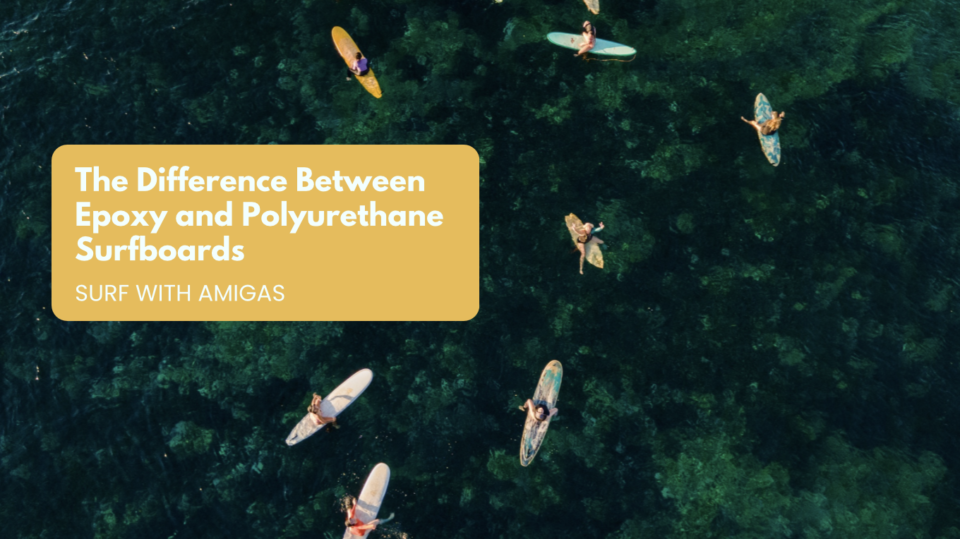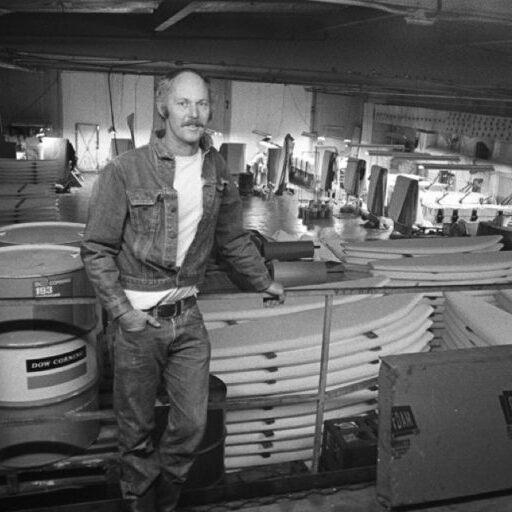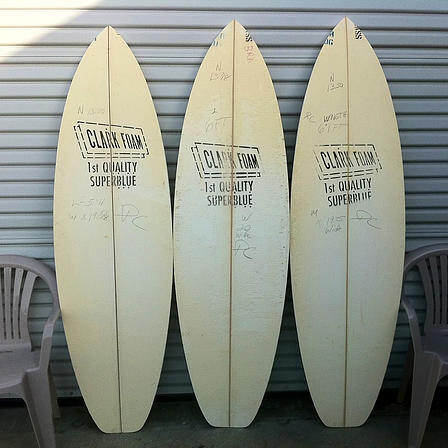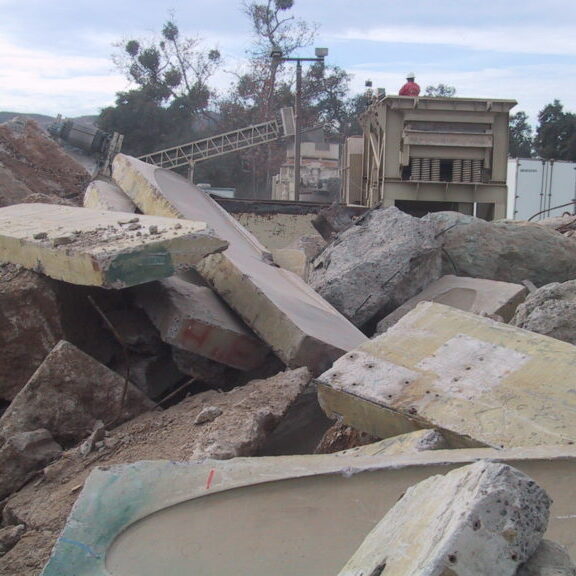We occasionally receive a message from an Amiga asking to be able to ride a “fiberglass board” on their Surf With Amigas Retreat as opposed to an epoxy board. The question always makes us grimace.
Unless the board is made from some unusual material like carbon fiber, ALL surfboards are wrapped in fiberglass. I think what most surfers are actually wanting is to avoid riding a “pop-out” board – as in the mass-produced SurfTech or NSP variety. When choosing a surfboard the actual factor to consider is whether the board is made with polyurethane (PU) or epoxy (EPS) foam.
Let’s Start with the Basics: How are Surfboards Made?
In case you have no idea how surfboards are constructed, we’ll start with the basics. Of course there are always experimental surfboards out there, but the vast majority of boards are made of a foam core wrapped in layers of fiberglass and laminated with resin.
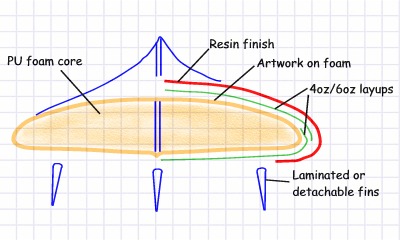
In the diagram here you see a foam core which can be “EPS” or “PU” (more on that in a bit), covered in layers of different weight fiberglass (in this case 4oz on top, 6oz on bottom), then laminated with resin. You can see the wooden stringer down the center represented as blue lines.
The surfboard starts as a “blank” which is a chunk of foam already in the general size and shape of a finished surfboard. The foam core, or blank, is formed in a large, cement mold roughly the shape of the surfboard. The mold is constructed in two halves, and the inside is lined with a special paper that keeps the foam from sticking to the mold. The two halves are clamped together and the mold is heated. When the liquid polyurethane chemicals are poured into the mold, the heat triggers a chemical reaction which begins forming a dense, white foam. Surfboard builders call this process, “blowing the blank.” After 25 minutes, the mold is opened and the foam core is taken out and allowed to finish hardening. Once the core is hard, it is cut in half vertically from the nose to the tail. A thin stringer is glued between the two halves, and the core is then clamped back together to dry. Stringers provide stiffness, strength, and the right amount of spring when the board is compressed through turns.
This process creates a blank that looks like a rough surfboard. It’s thicker, longer, and rougher than the finished product, but already more or less in the final shape. Surfboard shapers choose a blank closest in size to the board they want to make as the density is not uniform throughout. There is generally a slightly more dense outer layer and a softer inner layer. The shaper will then just use a planer to cut the blank down to the desired thickness, rail shape, tail shape and add bottom contour.
Here’s a Surfboard Shaping History Lesson:
From 1961-2005, 90% of American-made and 60% of surfboards made worldwide began as polyurethane foam (PU) blanks blown by Clark Foam in southern California. In 2005, citing difficulties from environmental regulatory agencies, he abruptly shut down his factory which sent shockwaves through the industry.
Vintage Gordon “Grubby” Clark in his foam factory, along with a lineup of three iconic Clark Foam “blanks”.
The sudden closing and destruction of the Clark Foam factory was seen as a big “f*ck you” to the industry and led to mild panic in some circles. Such was the power of this man and his near complete domination of the surfboard industry. See the photo on the right of the destroyed blank molds.
After the initial panic subsided, most shapers began to view the closure of Clark Foam as a good thing for surfboard material innovation. It ended a period of monopolistic control and created a new, free, open market for blank builders to come in with new technology and ideas. It also encouraged shapers to put more energy into experimentation with the more environmentally-friendly expanded polystyrene blanks. There are some benefits to the newer technology. For one, the density is uniform throughout the blank.
These new blanks are laminated with epoxy resins. Epoxy emits 50-75% fewer VOCs (volatile organic compounds) than polyester resin. Also epoxy is lighter than polyester. Under most circumstances, resin makes up a large part of a completed board’s overall weight. Not only is epoxy resin lighter than polyester, but less is needed per coat. This ends up meaning a much lighter surfboard – a big plus for most surfers. The biggest bonus however is the durability and strength of epoxy boards, not to mention the benefits to the environment.
TWO TYPES OF EPOXY FOAM
1. EXPANDED Polystyrene (EPS, beaded foam)
Expanded, or beaded, foam (EPS) is a relatively inexpensive and incredibly lightweight surfboard core. Manufacturers produce sheets of EPS by feeding tiny polystyrene spheres into a machine, then introducing steam coupled with a tiny amount of pentane gas to expand the beads and mold them to one another. The end result is an open cell foam, meaning that is very water absorbent. To combat this issue, shapers who use EPS foam usually add extra layers of fiberglass and epoxy resin to prevent any dings from penetrating deep enough to reach the foam. Epoxy resin is the only resin that can be used with EPS boards. The extra layers of fiberglass and resin make the boards stiffer and more solid feeling. It leads to a less flexible feel than a “traditional” board. A beginner surfer would not be able to tell the difference, but an advanced surfer who is compressing her board into high speed turns will definitely notice.
“Pop-out” boards are made using EPS foam, because the beads can be formed into specific molds. Often times these blanks are used without stringers relying on just the strength of the blank and the thicker layers of fiberglass in the glassing. The entire board is made in a mold or with vacuum bagging technology. This leads to the boards being less refined. They will be cheaper and more durable which makes them excellent for beginners who are not ready to invest in a more expensive surfboard. They are perfectly fine to learn on.
Originally, very few hand shapers use this type of EPS foam, because it is difficult to work with and nearly impossible to fine-tune with shaping tools (the beads retain their spherical shapes so well that any sanding causes whole chunks of foam to fall off, leaving the edges jagged). But recently better EPS with smaller cells has been created so that it now works for hand shaped boards as well. When Holly was a pro surfer getting boards from Rusty Surfboards, almost all of her boards were made of EPS foam and looking at the boards even up close, it would be very difficult for anyone to tell the difference of EPS vs PU in the finished board.
These days EPS foam technology has improved and high performance EPS blanks are available. Professional surfers and recreational surfers alike will choose EPS boards because of their environmentally friendly characteristics. They are also a lot lighter which makes them ideal for smaller waves or smaller surfers carrying bigger boards.
Characteristics of boards with Expanded Polystyrene (EPS) epoxy foam:
- more water absorbent foam
- lightweight
- extra layers of fiberglass + epoxy resin for ding prevention
- potentially more solid feel because of extra fiberglass + resin (less flexible for advanced surfers)
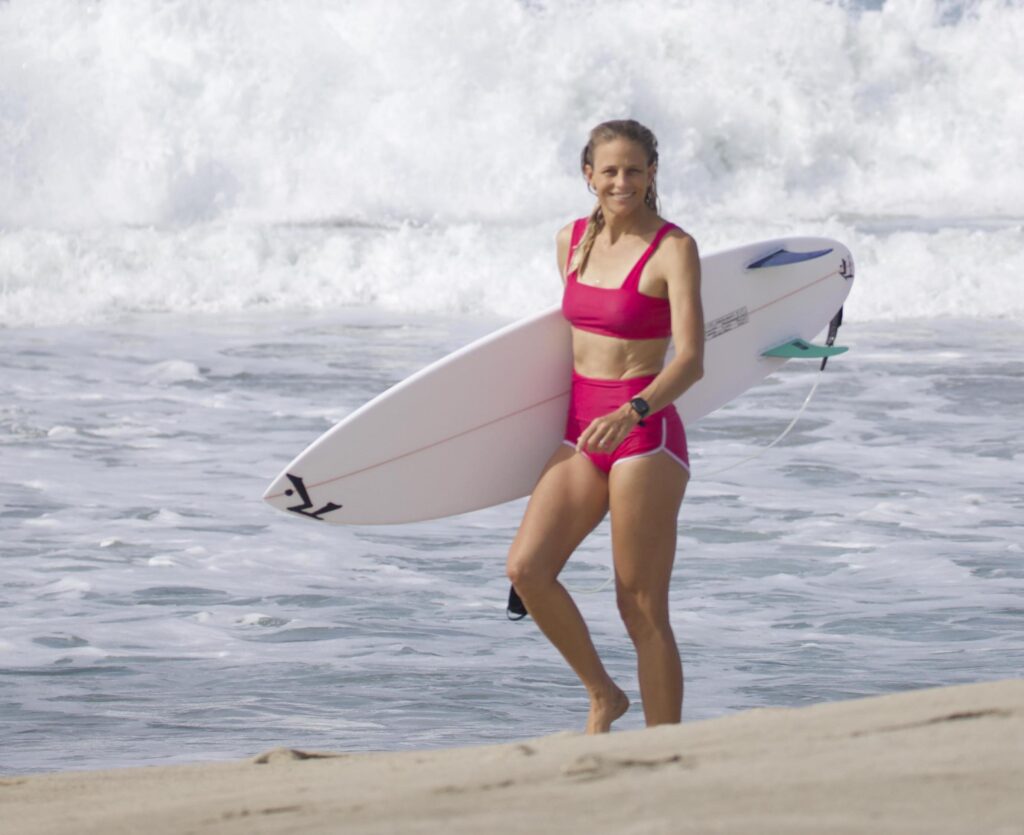
2. EXTRUDED (XTR, closed cell)
Extruded foam (XTR) is made using expensive machinery and computers. The machines melt polystyrene crystals down, using additives and a blowing agent to essentially deflate and combine all of the ingredients together. The result is a fluid that expands as it cools, forming solid blocks of XTR foam. The foam is closed cell, so it blocks out moisture – a good thing in case you get a ding.
The process of making XTR foam is time-consuming and costly. The price of the foam itself, coupled with the fact that most XTR epoxy boards are hand-shaped, does unfortunately lead to a more expensive finished board – but one with several benefits. Not only is the foam core moisture-wicking and stronger than other types of foam, it is also extremely resistant to dings and compression-caused dents. XTR foam also has a good flex pattern, so it’s responsive on the water.
The problem with closed cell foam is two-fold. First, as mentioned above, it is expensive. You will almost always pay more for an XTR board than one made from EPS. Second, there have been reports of bubbles and delamination in the decks of some closed cell boards, caused by gas build-up between the foam, fiberglass and resin layers. However, some companies have made huge developments in XTR-constructed boards, finding ways to allow the gases to escape without compromising the integrity of the surfboard.
Holly has an XTR board that she’s been riding hard for over 15 years that is still in very good condition, something virtually impossible with other types of construction.
Characteristics of boards with Extruded Polystyrene (XTR) foam:
- more expensive
- moisture wicking foam core (doesn’t absorb water even when dinged)
- stronger foam core
- good flex for advanced surfers
- extremely resistant to dings and pressure dents
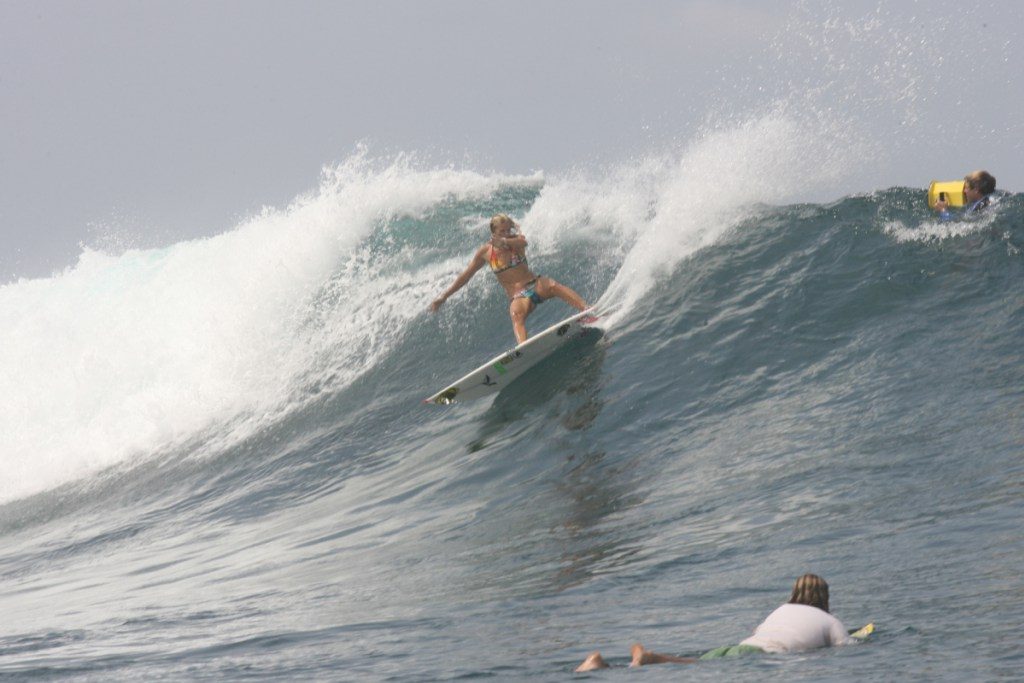
Riding my XTR board in really fun waves about 15 years ago. It still looks good and works just as well today.
OTHER TECHNOLOGIES:
TL2 by SurfTech
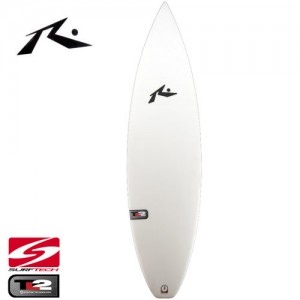 SurfTech makes a Techlite core (fused cell foam, virtually waterproof) technology they call the TL2 design. The Techlite core is further improved upon with the addition of an Acrylite skin, which is glassed onto the board using epoxy resin. The Acrylite skin and the epoxy coating work with the core material to create an incredibly strong, responsive surfboard. The extra strength means that no stringer is needed, so the board is more flexible and springy in the water as well.
SurfTech makes a Techlite core (fused cell foam, virtually waterproof) technology they call the TL2 design. The Techlite core is further improved upon with the addition of an Acrylite skin, which is glassed onto the board using epoxy resin. The Acrylite skin and the epoxy coating work with the core material to create an incredibly strong, responsive surfboard. The extra strength means that no stringer is needed, so the board is more flexible and springy in the water as well.
Hayden Shapes
Hayden Shapes is a quality surfboard manufacturer, also experimenting with different materials and designs. The Hypto Krypto is an awesome design for surfers wanting to go down in length but still keep paddle power since it has a wider nose for more planing but a narrower turn for high performance turns.
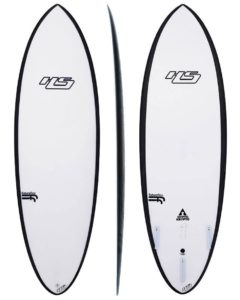 The construction combines a stringer-less, high-density custom shaped EPS core, laminated with biaxial fiberglass, epoxy resin and a parabolic carbon fiber frame. The carbon fiber frame within the laminate is the key to the performance vitality. Designed to maximize speed and drive while minimizing twist, FutureFlex essentially stores and releases energy as the surfer transitions through a turn. The FutureFlex construction creates a fast, dynamic and highly responsive surfboard that’s been design engineered for performance surfing ranging from the intermediate to advanced level.
The construction combines a stringer-less, high-density custom shaped EPS core, laminated with biaxial fiberglass, epoxy resin and a parabolic carbon fiber frame. The carbon fiber frame within the laminate is the key to the performance vitality. Designed to maximize speed and drive while minimizing twist, FutureFlex essentially stores and releases energy as the surfer transitions through a turn. The FutureFlex construction creates a fast, dynamic and highly responsive surfboard that’s been design engineered for performance surfing ranging from the intermediate to advanced level.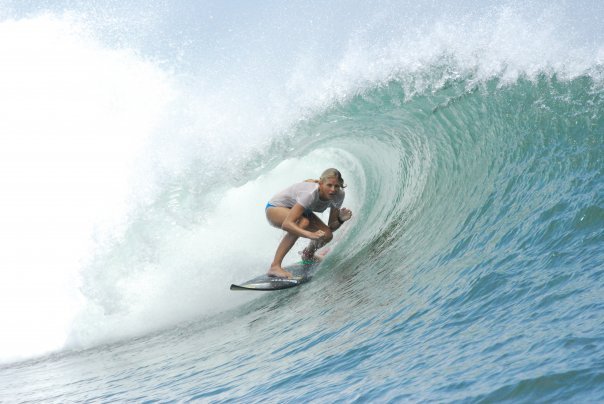
This is Holly riding a surfboard made by a company called Aviso that no longer exists. It’s a hollow-core (no blank at all) carbon fiber board. The construction is similar to the SCore in that it is hollow, but made fully of carbon fiber so they are all black. (Tricky to keep the wax on when surfing one in the tropics as they get really hot).
In summary – Epoxy vs Polyurethane
As described above, epoxy is lighter, stronger, and more environmentally friendly. An old EPS blank can be broken down and recycled into a new blank. The epoxy resin is less toxic to the board builder and the environment.
So what are the benefits of a lighter board? A lighter board is easier to carry, easier to paddle, and will often feel faster when riding them along the face of the wave. These all lead to more fun and froth, which is what it is all about. They are also very durable and maintain their integrity a lot longer than PU boards.
But, the epoxy boards can be stiffer and lighter which makes them tend to feel more “buoyant” and ride on top of the water, rather than in the wave. Since they are much more buoyant than PU boards, it is possible to ride shorter boards which can also enhance performance as the board fits better in the curve of the wave. Even pros ride EPS boards in smaller to medium-sized waves.
However, this buoyant feeling can make some people not like them. Also “pop-out” boards are made from this technology which can give the materials a bad name since they are associated with the image of cheaply produced junk.
In smaller, weaker surf, or for a beginner, the lightness is a really good thing. You will get the best weight to strength ratio with EPS/Epoxy construction; hand-built, composite, molded or otherwise. You’ll be able to lift a large board and carry it more easily to the water. For a surfer that is doing fast turns, the lightness of an EPS core combined with the strength of epoxy resin, will make for a more responsive, lively board.
It’s important to note that in bigger surf or choppy conditions, experienced surfers may actually prefer a slightly heavier board. Some older surfers who’ve gotten used to their PU boards will tell you that the feel and flex of a PU board is a feeling that will stick with you. Epoxy boards can have a “corky” feeling to them that can take some getting used to. Also, chop and windy conditions can make a lighter board feel like it’s bouncing more rather than plowing through the chop. Bigger waves are nice on heavier boards, especially if it’s also windy. In that case a PU blank with Polyester resin may be better.
A middle ground option is using a PU blank with Epoxy resin. Polyester resin will eat away (think: more nasty chemicals) EPS foam, but you can use epoxy resin with PU blanks so that’s a good compromise if you’re looking for the flex and weight of a PU blank with the environmental friendliness and durability of Epoxy.
Our advice: Get the board that you have the most fun on and makes you the happiest, because in the end, it doesn’t matter what you ride, as long as you are stoked.
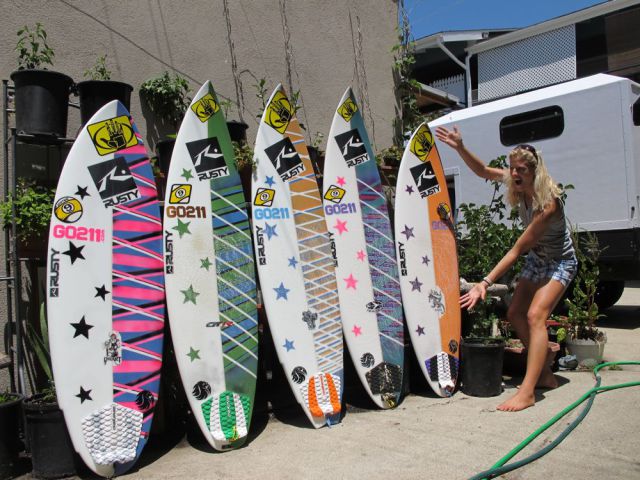
Any guesses which of these are EPS and which are PU? It’s impossible to tell at a distance.

